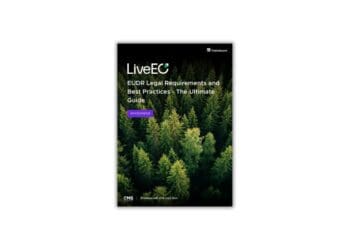Real estate-related assets account for about 40% of global CO2 emissions, which means companies cannot get a handle on their ESG impact without understanding their owned and leased real estate footprint. Joe Fitzgerald of Visual Lease offers tips for leveraging lease management to create a more sustainable future.
A staggering 99% of senior real estate executives believe it is important for their organization’s future leases to help reduce its carbon footprint. But without visibility into the current environmental impact of their owned and leased assets, businesses cannot reasonably set accurate, achievable sustainability goals.
Thankfully, the introduction of the lease accounting standards (ASC 842, GASB 87 and IFRS 16) shined a light on the need for strong lease management — a process that remains critical to sustaining lease accounting compliance. And given that nearly 40% of global carbon dioxide emissions originate from real estate-related assets, proper lease management is an organization’s entry point to not only measuring and reporting on their environmental impact but also, understanding how to make improvements for a more sustainable future.
As the landscape of ESG reporting continues to evolve with the introduction of global sustainability disclosure standards from the International Sustainability Standards Board (ISSB) this past June, there are clear steps that companies can take to successfully report on and improve their environmental impact:
1. Assemble a dedicated team
At first glance, many assume that ESG reporting should live entirely with the office of finance. But when reviewing the new international sustainability standards from the ISSB, it is critical for businesses to prioritize tracking a wide variety of environmental factors, including energy consumption, water usage, waste management and more — data that should be contained within a company’s portfolio of owned and leased assets. Therefore, all teams that interact with these assets need to be involved in their organization’s sustainability efforts.
Establish a dedicated task force with representation from finance, as well as real estate, procurement, legal, etc. From the onset, determine roles, such as who will be tasked with flagging new modifications or terms within your organization’s lease portfolio versus who will be responsible for keeping up with evolving ESG reporting guidance from regulatory bodies, including the ISSB, as well as the SEC.
New Challenge for US Compliance and Risk Leaders: Aligning With EU Sustainability Directive
Despite the flurry of real and rhetorical backlash against ESG reporting in the United States, many U.S. companies will not be able to escape stringent sustainability reporting requirements emanating from the EU. And the time to gear up for compliance is short, writes Lukas Tunikaitis, sustainability consultant in UL Solutions’ ESG advisory and assurance practice.
Read moreDetails2. Perform a gap analysis
Once key roles and responsibilities have been established, dedicate a specific window of time to evaluate the current state of your organization’s lease and asset management practices, including all related processes and systems — or lack thereof.
Prioritize getting a handle on all relevant data. When it comes to tracking and measuring environmental impact, organizations should start by gathering and analyzing their lease and owned asset records to identify consumption data of greenhouse gas emissions (CO2, PFCs, CH4, SF6, N2O, HFCs).
3. Establish a strong internal controls framework
Leases are often one of a business’s largest expenses, second only to people-related costs like payroll and benefits. In this economic climate, it’s critical to prioritize platforms that not only allow you to maintain a centralized system of lease and owned asset records but also empower you to establish a strong internal controls framework around these records and related data.
Controls within this category encompass policies and procedures that are designed to prevent and/or detect unauthorized acquisition and use or disposition of right-of-use assets. By implementing these controls, organizations can significantly mitigate the risks associated with misreporting financial data. This includes avoiding failed audits, costly penalties and reputational damage that could result from non-compliance.
Having a robust internal controls framework also enforces the roles and responsibilities of each stakeholder by enabling access to the appropriate point of contact at the appropriate point in time while also facilitating communication and collaboration among teams.
Strong internal controls will ensure that your lease and owned asset records, as well as the records needed to track your carbon footprint, are accurate and complete, providing you with the ability to use this data as fuel to guide future decisions to drive financial and sustainable success.
4. Consider outside expertise and assistance
Successful ESG reporting and goal setting hinges on an organization’s adaptability. It is critical to consider outside resources to help strengthen your efforts and ensure that you are effectively staying ahead of what’s ahead in this developing landscape.
Consultants with compliance or sustainability expertise can help your organization set its foundational ESG policies, keep you abreast of changing requirements, and provide ongoing support and guidance on the path to meeting your goals. They can and should function as an extension of your internal team, assisting by monitoring regulatory changes and helping to update reporting frameworks accordingly. These individuals also offer outside perspectives, drawing on their experience working with diverse organizations across various sectors, helping you to refine your approach and ensuring your goals are ambitious, measurable and aligned with the most current industry benchmarks.
The key to unlocking increased visibility, new efficiencies and data to support ESG efforts is to first implement processes and technology that supports all of these areas. Without it, your organization will have a difficult time complying with emerging regulatory requirements and sharing its environmental impact with investors, consumers and employees alike — a risk that is too big to take.




 Joe Fitzgerald is senior vice president of lease market strategy at
Joe Fitzgerald is senior vice president of lease market strategy at 








